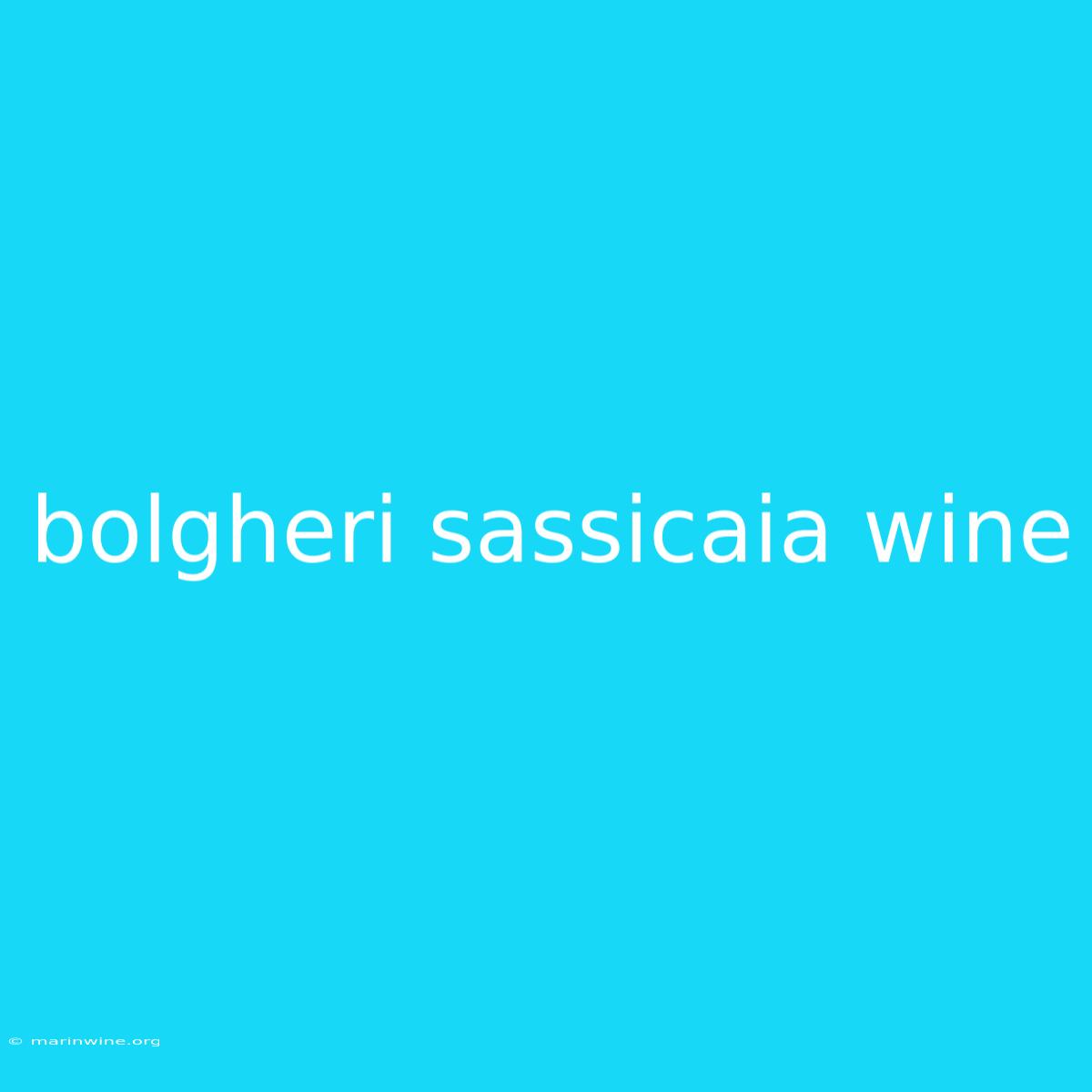The Legend of Sassicaia: Unveiling the Secrets of Italy's Most Famous Wine
Have you ever heard of a wine so legendary that it single-handedly changed the course of Italian winemaking? This is the story of Sassicaia, a bold and complex wine that has captivated the world with its undeniable quality and unwavering prestige.
Why This Matters: Sassicaia is more than just a wine; it's a symbol of Italian winemaking excellence. Its journey from humble beginnings to becoming a global icon is a testament to the dedication of its creators and the power of innovation. This article dives into the fascinating history, key characteristics, and enduring legacy of this remarkable wine.
Key Takeaways of Sassicaia:
| Feature | Description |
|---|---|
| Origin: | Bolgheri, Tuscany, Italy |
| Grape Variety: | 100% Cabernet Sauvignon |
| Style: | Full-bodied, complex, and age-worthy |
| Price: | Considered a luxury wine, often priced at over $100 per bottle |
| Awards and Recognition: | Consistently receives top scores from leading wine critics and publications |
The Birth of a Legend: Sassicaia's Story
The tale of Sassicaia begins in the 1940s, with the vision of Marchese Mario Incisa della Rocchetta. Determined to produce a wine that rivaled the finest Bordeaux, he planted Cabernet Sauvignon vines on his estate in the Bolgheri region of Tuscany, a daring move at a time when the dominant grape in the area was Sangiovese.
His initial efforts, under the name “Sassicaia,” were met with skepticism. Many questioned the suitability of Cabernet Sauvignon to the Tuscan terroir. Yet, Incisa della Rocchetta persevered, experimenting with different techniques and relentlessly pursuing excellence.
The Rise of a Champion: The Transformation of Sassicaia
In the 1970s, Sassicaia experienced a pivotal turning point. The wine's quality was finally recognized, and it received high acclaim from leading wine critics. This recognition catapulted Sassicaia to the forefront of the Italian wine scene, paving the way for the rise of Bolgheri as a world-renowned wine region.
Key Aspects of Sassicaia Wine:
Terroir and Climate:
The unique terroir of Bolgheri, characterized by sandy soils, a Mediterranean climate, and moderate rainfall, plays a crucial role in shaping Sassicaia's distinctive character. The warm, sunny days and cool nights contribute to the slow ripening of the Cabernet Sauvignon grapes, resulting in wines with intense fruit flavors and complex aromas.
Winemaking:
Sassicaia is produced using traditional French winemaking techniques. After a long maceration process, the wine undergoes malolactic fermentation and is aged for a minimum of 24 months in French oak barrels. This rigorous process ensures a wine with remarkable depth, complexity, and age-worthiness.
Flavors and Aromas:
Sassicaia is known for its intense, concentrated flavors of black fruit, such as blackberries and black currants. The wine also displays complex aromas of leather, tobacco, cedar, and earthy notes. These flavors are complemented by a smooth and elegant tannins, creating a well-structured and harmonious wine.
The "Super Tuscan" Revolution:
Sassicaia's success sparked a revolution in Italian winemaking. Its innovative approach, using non-traditional grapes and techniques, led to the emergence of a new category of wines known as “Super Tuscans.” These wines, like Sassicaia, push the boundaries of Italian winemaking, showcasing the potential of different grape varieties and producing wines that rival the world's best.
The Legacy of Sassicaia:
The impact of Sassicaia extends far beyond its own exceptional quality. It has left an enduring legacy, inspiring countless producers in Italy and beyond. The wine has played a significant role in raising the profile of Italian wine on the international stage, demonstrating that Tuscany can produce world-class wines that can compete with the finest Bordeaux.
FAQ for Sassicaia Wine:
Q: How much does Sassicaia cost?
A: Sassicaia is considered a luxury wine, and its price varies depending on the vintage and retailer. Generally, it retails for over $100 per bottle.
Q: What is the best way to store Sassicaia?
A: Sassicaia should be stored in a cool, dark place with a consistent temperature. Ideally, the wine should be stored lying down to ensure that the cork stays moist and prevents oxidation.
Q: How long can Sassicaia age?
A: Sassicaia is an age-worthy wine, with the potential to age for decades. The wine's tannins and acidity allow it to develop complexity and elegance over time.
Q: What are some alternative wines to Sassicaia?
A: If you're looking for similar wines, consider exploring other Super Tuscans like Tignanello, Ornellaia, and Solaia. These wines share a similar style and character, with their own unique twists.
Q: Is Sassicaia a good investment?
A: Sassicaia is considered a good investment for wine collectors. Due to its limited production and consistent high quality, the wine's value tends to appreciate over time.
Tips for Enjoying Sassicaia Wine:
- Decant the wine for at least an hour before serving. This allows the wine to breathe and release its full bouquet of aromas.
- Serve Sassicaia at a temperature of 16-18°C (61-64°F). This temperature allows the wine's flavors to shine without being too cold or too warm.
- Pair Sassicaia with rich, complex dishes like grilled meats, roasted vegetables, or aged cheeses. These dishes complement the wine's bold flavors and tannins.
Summary of Sassicaia Wine:
The story of Sassicaia is a testament to the power of vision, innovation, and relentless pursuit of excellence. From its humble beginnings to its status as a global icon, this wine has redefined the world of Italian winemaking. Its exceptional quality, complex aromas, and enduring legacy continue to inspire wine lovers and producers around the globe.
Closing Message:
The next time you encounter a bottle of Sassicaia, take a moment to appreciate its fascinating history, its distinctive character, and its lasting impact on the world of wine. This is a wine that deserves to be savored and enjoyed for its extraordinary depth and undeniable brilliance.

